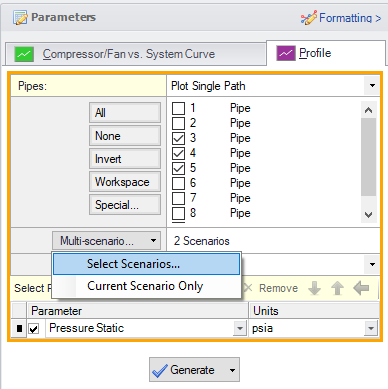Graph Types
AFT Arrow offers several types of graphs to help users better understand and interpret their data. Each type of graph is given a brief description below.
Compressor/Fan vs. System Curve
This graphing option allows you to plot a Compressor/Fan curve versus a system curve for a single Compressor/Fan or group of Compressor/Fans.
Note: The Compressor/Fan Curve vs. System Curve is only available if there is a Compressor/Fan in the model
You can create Compressor/Fan vs. system curves for complex parallel flow networks. Composite Compressor/Fan curves for Compressor/Fans in parallel or in series can also be also generated. If you create a composite Compressor/Fan curve, you can also show single Compressor/Fan curves on the same graph. If efficiency data exists you can cross-plot the efficiency curve.
Compressor/Fan vs. System curves can be displayed in two ways when parallel Compressor/Fans are selected. The first method is the “traditional” method, used primarily in earlier versions of AFT Arrow. The second method is called the “enhanced” method which attempts to determine the flow split on the Compressor/Fans and adjust the system curve accordingly. It also attempts to create a better composite curve when parallel Compressor/Fans are dissimilar. For more information see Compressor/Fan vs. System Curve Methods.
Compressor/Fan vs. System curves for different scenarios can be plotted together on one graph by adding individual curves to a Multi-Scenario Compressor/Fan Vs. System Folder, then loading them together in a single Multi-Scenario graph. For detailed information on how to do this see Multi-Scenario Compressor/Fan vs. System Curves Tutorial.
Profile
This graph category will allow you to plot the selected parameter(s) along a flow path. In order to generate this graph, the specified pipes in the Select Graph Parameters window that comprise the path must form a single, continuous path. If they do not, an error message will appear and inform you which pipes are preventing the path from being continuous. The independent variable in these graphs is the length along the pipe(s).
A path of pipes can be specified in one of two ways. First, the user can select the pipes in the displayed list. Additionally, you can select the path on the workspace, and then use the Workspace button on the Select Graph Parameters window to automatically select all pipes currently selected on the Workspace. These methods permit that only a single path to be specified.
A profile graph can also be generated directly by selecting a single, continuous flow path in the Workspace, then right-clicking the Workspace and choosing the desired parameter under "Generate Profile Graph."
One or more flow paths can be specified using groups. Only those groups that consist of a continuous pipe sequence will be displayed as an option in the Select Graph Parameters window.
Multi-Scenario Graphing Features
Starting with Arrow 9, users can plot information from multiple scenarios in the same graph for profile plots (or Transient plots with the XTS Module). Note Multi-Scenario Compressor vs System curves are generated using a different method.
In the Select Graph Parameters window, the Multi-Scenario button allows users to select the scenarios in the model they wish to plot for a particular graph. The same pipe layout must exist for all scenarios being plotted in a graph. Design alerts cannot be included in multi-scenario plots.
The active scenario must be included in a multi-scenario graph. When creating a new graph, users are not able to deselect the current scenario. When a user loads a saved Graph List Item that does not include the active scenario, Arrow will add the active scenario into the Graph List Item, but will not save the active scenario into it.
Scenarios can be selected using the Multi-scenario... button as shown in Figure 1 below.

Figure 1: Graph Parameters window showing Multi-scenario selection options



